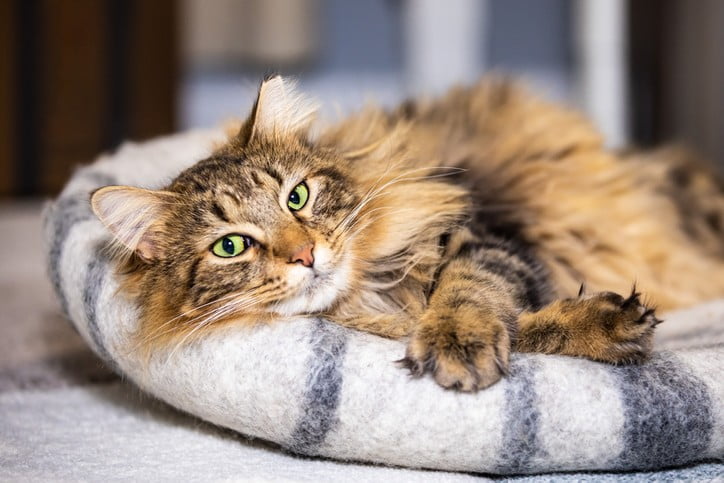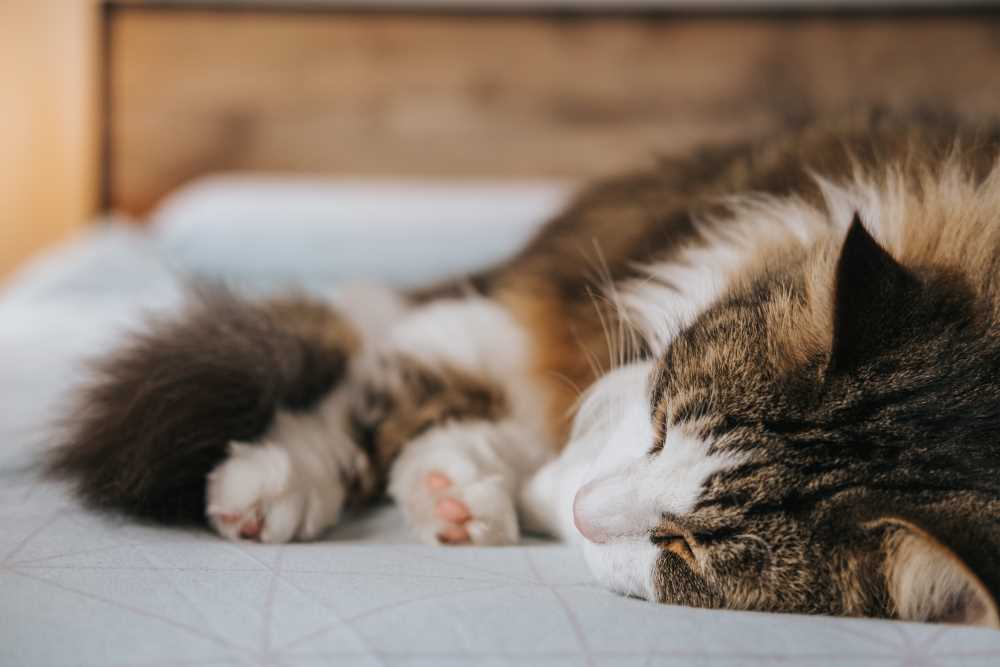How to Take Care of a Cat With Arthritis

Did you know that osteoarthritis (OA) or simply arthritis affects an estimated 1 in 3 cats over the age of 10? It is a disease that causes inflammation and degeneration of one or more joints.
While cats are known as swift and agile creatures, this disease can hinder their mobility and cause a lot of pain for them. This is why, it’s important to know how to take care of a cat with arthritis.
What is Cat Arthritis?
Cat arthritis, scientifically known as osteoarthritis (OA), is a debilitating degenerative joint disease that afflicts felines, potentially stemming from multiple factors including the natural aging process, previous injuries, or genetic predisposition. To provide optimal care for your beloved cat, it’s vital to grasp the intricacies of this condition.
Osteoarthritis primarily involves the gradual breakdown of joint cartilage, leading to pain, inflammation, and impaired mobility. The joint cartilage, which acts as a cushion between bones, becomes worn over time. As a result, the bones may start to rub against each other, causing discomfort and further damage.
Detecting the early signs of arthritis is pivotal. Cats are masters at concealing their pain, but subtle changes in behavior can serve as crucial indicators.
Watch for reduced mobility, as arthritic cats often hesitate or struggle to climb stairs, jump onto surfaces, or engage in play. Stiffness, especially after periods of rest, may also manifest. Reluctance to jump or play, as well as vocalization due to pain, can be telltale signs that your feline friend is grappling with this joint disease.
Understanding cat arthritis is the initial step in ensuring your cat’s quality of life. By identifying these subtle cues early on, you can take proactive measures to alleviate their discomfort and enhance their overall well-being.
How to Tell If a Cat Has Arthritis – Potential Symptoms

Detecting arthritis in cats can be challenging since they are experts at concealing pain.
However, several telltale signs and symptoms can help you determine if your feline companion is suffering from this joint condition. By keenly observing their behavior and seeking professional guidance, you can provide timely care and support to improve their quality of life.
- Changes in Mobility: One of the most noticeable signs is a decrease in mobility. Arthritic cats may move more slowly, experience stiffness when getting up, or have difficulty climbing stairs or jumping onto elevated surfaces.
- Litter Box Issues: Arthritis can make it painful for cats to squat and use the litter box. If your cat starts having accidents outside the box or exhibits changes in their toileting habits, it could be a sign of arthritis.
- Altered Grooming Habits: Cats are meticulous groomers, but those with arthritis may have difficulty reaching certain areas of their body. This can lead to a decline in grooming, resulting in a matted or unkempt coat.
- Behavioral Changes: Cats in pain may exhibit changes in behavior. Look for signs of irritability, aggression, or a reluctance to be touched, especially around affected joints.
- Vocalization: Cats with arthritis may vocalize more frequently, especially when moving or attempting to jump.
- Loss of Appetite: Chronic pain can lead to a decreased appetite. If your cat is eating less than usual, it could be due to discomfort from arthritis.
- Lethargy: Arthritic cats may become less active and spend more time resting.
- Swelling and Joint Deformities: In advanced cases, you may notice joint swelling or deformities, although these are less common.
If you suspect your cat has arthritis, consult your veterinarian. They can perform a physical examination, potentially use X-rays for a definitive diagnosis, and recommend a suitable treatment plan. Early detection and intervention can greatly improve your cat’s comfort and quality of life, allowing them to enjoy their golden years to the fullest.
Treatment Options for a Cat with Arthritis
When it comes to alleviating the discomfort and pain associated with arthritis in cats, several treatment options are available to enhance their quality of life. These treatments can be broadly categorized into medical interventions and lifestyle modifications.
Medical Interventions:
- Pain Medications: Nonsteroidal anti-inflammatory drugs (NSAIDs) are often prescribed by veterinarians to manage pain and reduce inflammation in arthritic cats. These medications can significantly improve a cat’s comfort and mobility.
- Joint Supplements: Joint supplements containing glucosamine and chondroitin sulfate can promote joint health and slow down the progression of arthritis. They are typically available in various forms, including chewable tablets and liquid formulations.
- Corticosteroids: In some cases, corticosteroids may be used to reduce inflammation and alleviate pain. However, their long-term use may have potential side effects and should be carefully monitored.
Lifestyle Modifications:
- Weight Management: Maintaining an ideal weight is crucial for arthritic cats. Obesity exacerbates joint strain, so a balanced diet and portion control are essential.
- Physical Therapy: Gentle exercises and range-of-motion activities can improve joint mobility. Encourage your cat to engage in low-impact play and provide opportunities for stretching.
- Comfortable Living Environment: Ensure your home is adapted to your cat’s needs. Soft bedding, ramps, and easily accessible litter boxes can make a significant difference.
- Alternative Therapies: Consider complementary treatments such as acupuncture, massage therapy, or hydrotherapy, which can provide additional pain relief and improve your cat’s overall well-being.
- Heat Therapy: Applying heat to arthritic joints can provide significant relief. Many veterinarians recommend using a heating pad for this purpose. Remember to always monitor your cat during heat therapy to ensure they are comfortable and not overheating.
The right combination of these treatment options, tailored to your cat’s specific needs, can significantly enhance their comfort and happiness as they navigate life with arthritis.
Taking Care of a Cat with Arthritis at Home

Taking care of a cat with arthritis at home is perhaps the best way to ensure the pet’s comfort. Here are some factors to consider for this purpose:
Diet and Weight Management:
Diet plays a pivotal role in managing arthritis in cats. Maintaining your cat’s ideal weight is essential to reduce stress on their already aching joints. Excess body weight places additional strain on the joints, exacerbating the discomfort.
Consult your veterinarian for dietary recommendations tailored to your cat’s needs. They can recommend specially formulated cat foods designed to support joint health, which often contain beneficial ingredients like glucosamine and chondroitin.
Encouraging Exercise and Playtime:
Although it may seem counterintuitive, regular exercise is crucial for cats with arthritis.
Gentle, low-impact exercise helps keep their muscles and joints active, preventing stiffness and further deterioration. Interactive toys, feather wands, and laser pointers can engage your cat both mentally and physically without subjecting them to excessive joint strain. Be sure to supervise playtime and ensure that it remains gentle and appropriate for their condition.
Creating an Accessible Environment:
Arthritic cats may struggle to reach their favorite spots, like sofas, beds, or windowsills. To make their life more comfortable, consider adding ramps or steps to help them access elevated areas without straining their joints. Additionally, provide soft and supportive bedding in various locations to offer your cat comfortable resting options throughout the day.
Administering Medication at Home:
Depending on your veterinarian’s recommendations, administering medication at home may be necessary for effective pain management. They will provide specific instructions on how to safely and effectively administer medications, which may include nonsteroidal anti-inflammatory drugs (NSAIDs) or joint supplements. It’s crucial to follow these instructions meticulously to ensure your cat receives the proper dosage and timing.
Natural Remedies:
Some cat owners prefer natural remedies to manage their cat’s arthritis. Discuss these options with your veterinarian, who can guide their safety and efficacy. Common natural supplements for arthritis include fish oil, which contains omega-3 fatty acids with anti-inflammatory properties, and turmeric, known for its potential pain-relieving benefits.
Conclusion
In conclusion, the journey of caring for a cat with arthritis is a comprehensive one, demanding a combination of veterinary expertise, attentive home care, and a deep appreciation for your cat’s distinct requirements.
With a thoughtfully crafted treatment plan and a nurturing, encouraging environment, cats living with arthritis can experience contentment and comfort as they gracefully age. It’s paramount to maintain a continuous partnership with your veterinarian, seeking their guidance as your cat’s condition evolves.
By unwaveringly dedicating yourself to your cat’s well-being, you provide them with the opportunity to savor their golden years to the absolute fullest, ensuring that each day is filled with comfort and love.


